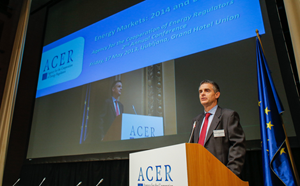Concrete suggestions for improvement (part II)
on
Interview: Alberto Pototschnig – Director of ACER
Concrete suggestions for improvement (part II)
Recently ACER published the second annual Market Monitoring Report 2013, prepared in collaboration with the Council of European Energy Regulators. In this second half of EER’s interview with ACER’s Director Alberto Pototschnig, the latter elaborates on REMIT, more concentrated regulation and ACER’s plans for 2014.
 |
| ACER’s Director Alberto Pototschnig (c) ACER |
The Network Code on Harmonised Transmission Tariff Structures in the gas sector, as well as similar network or market rules to be enacted at EU level in both electricity and gas, will defines rules to be applied consistently across all Member States. Common methodologies will be used for the calculation and fine-tuning of transportation tariffs across borders. This will prevent potential discrimination against cross-border trade and minimise flow distortions. Harmonised tariff structures, combined with the bundling of capacity products on either side of a cross-border interconnection point, will help avoid inefficiencies. In the electricity sector, the situation is already more advanced thanks to the implementation of supra-regional market coupling or splitting.
The Agency is instrumental in coordinating National Regulatory Authorities.
| I do not see regional regulatory authorities emerging any time soon, but stronger regional cooperation could bring great benefit in promoting market integration and the early implementation of the rules contained in the network codes |
Although REMIT, preventing market abuse and ensuring market integrity and transparency, entered into force in 2011, it has not been implemented yet. Which steps are still missing in this implementation phase and what benefits will its application bring to the EU traders and consumers?
REMIT will be implemented fully only once the data reporting obligations enter into force, which is dependent on the adoption of the implementing acts by the European Commission. The implementing acts will be adopted following a comitology process involving representatives from the Member States, which is scheduled to start in late December 2013. Currently the data reporting obligation is foreseen to enter into force in the second half of 2014 at the earliest.
Once trade data reporting starts – and REMIT is fully implemented – the Agency will be able to effectively and efficiently monitor the European wholesale energy market, to detect and deter trading based on inside information and market manipulation It will ensure market integrity and transparency to the benefit of European energy consumers and citizens. Such a framework is unprecedented in the energy sector - and not only in Europe- for its geographical scope with multijurisdictional coverage. But also because of its complexity – requiring the reporting of individual transactions. How the monitoring of wholesale energy markets will be organised in the future is still unclear. It will crucially depend on the human resources – in terms of expert market analysis capabilities - available to the Agency. In 2014 we aim to define the most efficient approach to market monitoring on the basis of the available resources. Based on the experience in the US, the benefits of market integrity and transparency are likely to be manifold larger than any resource costs involved in effective monitoring. Therefore, I am confident that the Agency will be put in a position to fulfil its mission under REMIT in the effective way that European energy consumers deserve.
How would you evaluate 2013 for the Agency and what challenges will it face in 2014?
In November we adopted the last of the eight Framework Guidelines which were identified by the Commission as priorities for the completion of the Internal Energy Market by 2014. We have also contributed to the successful implementation of the TEN-E Regulation, which entered into force in May. Thanks to the concerted effort of all the parties involved, the first EU-wide list of Projects of Common Interest (PCI) was agreed by Member States in July and finally adopted by the Commission in October. The Regulation and the list represent a significant step forward
| Looking forward, 2014 will be a critical year for the European energy markets, with the target date for the completion of the internal electricity and gas markets, and therefore for the Agency as well |
| The first part of this interview appeared Thursday 16 January 2014. |


Discussion (0 comments)